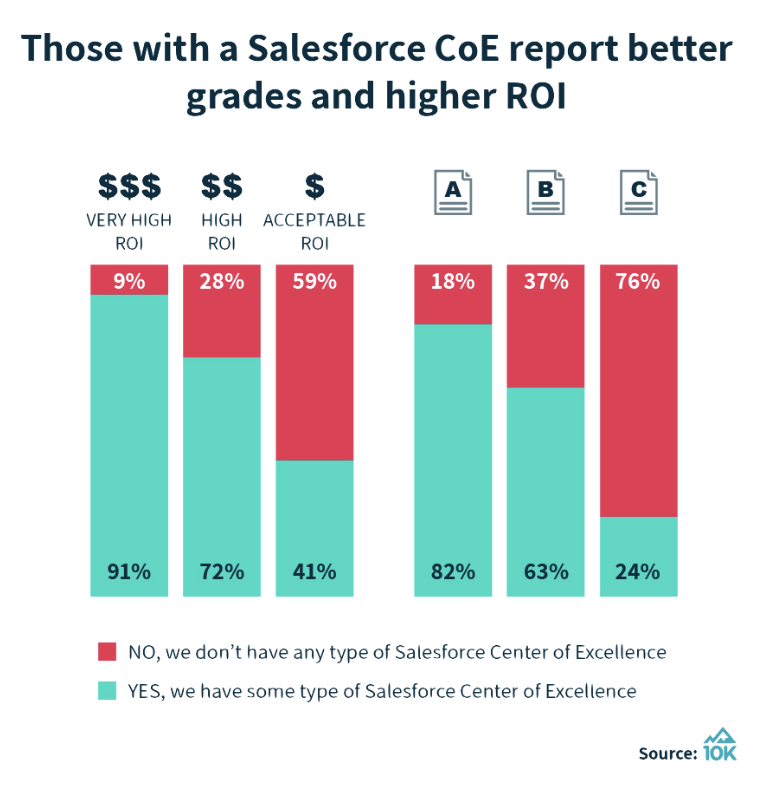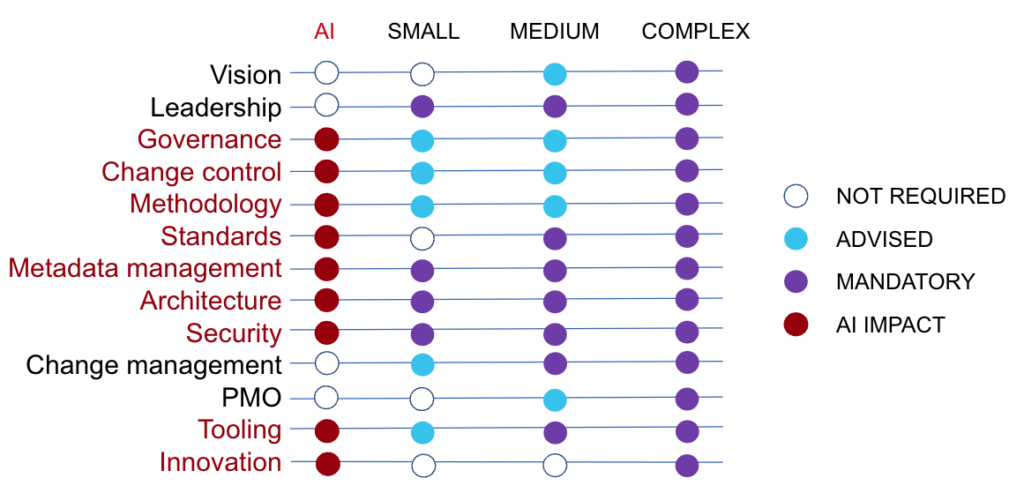
Taylor Swift and Center of Excellence
The last 23 years
We’ve been customers since 2001. Salesforce has changed dramatically since then from a Sales Force Automation app (tactical) to a customer experience platform (strategic) with many customers spending over $20m/year.
The power, scope and complexity of the Salesforce platform, has increased dramatically.
At the same time, a growing ecosystem of Trailblazers is inspired by the potential of learning through Trailhead. However, far more expansive implementation skills are required, to run increasingly complex Orgs.
The expectation set by marketing, sales and Trailhead, that Salesforce is “so quick and simple anyone can get it going in days,” is no longer true for many customers. These are risky, strategic and costly project implementations; the penalties of failure are high.
Customers of all sizes are struggling with levels of technical debt, that kill agility. This is (at least in part) due to the low levels of implementation maturity, compared with the general IT industry. The good news is that these are “solved problems” in other ecosystems, where the implementation maturity is much higher.
All research and experience points to the importance of implementing a Center of Excellence.
Growing pains
Having been a customer since 2001, we never could have imagined the changes over the last 20 years. Salesforce has broken records in the IT industry for growth and democratizing app development. It has been an amazing ride.
Back in 2001, there were just 5 objects and no AppExchange nor Trailhead. Sandboxes didn’t exist. But the huge power of the platform was evident.
For those of us with years of experience in Oracle, SAP or custom IT implementations, the speed, flexibility and potential to configure Salesforce took our breath away. For our own business, back in 2002 we built 300+ custom objects to run all aspects of our operations with clicks, not code. Salesforce was our core platform. Cloud, or ASP as it was called then, meant our teams around the world had access to a single source of truth for all customer data: customer-360.
There were no IT barriers to scaling our business internationally. Amazing.
Fast forward 20 years. Salesforce has invested heavily through R&D and M&A to expand the platform capabilities and integrations, to the corporate IT landscape. The scope and complexity of projects has expanded massively. Customers are committing to Salesforce as a strategic platform and it is the single source of customer data access, across their enterprise. Add to that, the power of AI and big data. That rapid growth and success has enabled Salesforce to go from a tactical sales automation app, to a strategic platform for many of the 200,000 customers.
So far, so good.
Warning signs
A key issue, that has been recognised by Salesforce over the last 2-3 years, is the increasing levels of technical debt in Orgs. Technical debt is at crippling levels in mature orgs. It kills agility, which ironically was the most compelling reason for using Salesforce in the first place. It stops customers adopting more Salesforce technologies and puts renewals at risk.
Back in 2017, John Rymer from Forrester wrote an article called the “Salesforce @scale dilemma.” The article maintains that current issues of technical debt are a “challenge for clients to overcome, rather than an inevitable outcome of large-scale, strategic Salesforce implementations.”
Rymer goes on to say, “initial success breeds demands for more. Business leaders want to expand initial wins. New custom applications and customisations mushroom. The complexity of scale crushes Salesforce’s responsiveness. Innovation slows and flexibility evaporates.”
“Every app change, risks breaking one of hundreds of data and process customisations, integration links, and third-party add-ons. The result: every change requires long and expensive impact-analysis and regression testing projects.”
We’ve analyzed over 20 billion Org metadata items and the scale of Org customizations is staggering. Here are the highest numbers of metadata items we have seen in Orgs: 250,000 reports, 50,000 email templates, 2,000 custom objects, 400 record types on an object, 20,000 custom fields, 13,000 dashboards, 100 managed packages, 18 million cases, 1.4x storage limit. There was an org with 10 million task records, which we thought was jaw-dropping, only to be beaten the week after when we analyzed an Org with 114 million tasks!
Rubber Duck Race to global sensation
The Taylor Swift story from her playing a tiny gig, at the Nashville Rubber Duck Race (full story, shared below,) to having a blockbuster film about her recent Eras Tour, has strong parallels with Salesforce.
Taylor Swift’s The Eras Tour is sold out with #swifties organizing their life around seeing it live. At every venue. In every country. Taylor Swift’s tour has generated over $1billion in ticket sales. It has 146 shows, from 17 Mar 2023 to 23 Nov 2024. The tickets for every venue, sold out in hours. StubHub noted that the Eras Tour ticket sales were “tracking to be the best-selling of any artist [they’ve] seen.” Live Nation, the parent company of Ticketmaster, said they prepared for 1.5 million verified fans, but 14 million turned up.
From startup to CRM #1
Back in 2001 Salesforce was relatively simple with a narrow scope; sales automation, for a small group of people. The speed and flexibility of Salesforce was amazing. And if it stopped working? No biggie, only a few people were impacted.
But now in 2023, Salesforce is the #1 market leader. It is the core platform inside a customer’s organizations. So the entire organization depends on it. Having a customer-360 view is a competitive advantage for the organization. It is strategic, and unplanned downtime is unacceptable.
What does it take to execute a world multi-stadium tour… or run a strategic Salesforce org?
It requires a Tour Director, promotors, music and dance director, band, backing singers and dancers, venues, a stage with lights and amplification, roadies, technicians, logistics and transport, catering, health and safety, and PR & communications.
It is a team effort and the winning teams have the best leadership, the best partners and the best personnel; all of them, completely aligned.
Here is the full detail of what it really takes to run a stadium tour.
Not all of these relate directly to the roles, skills and tools on Salesforce projects, but broadly:
- Best leadership: CIO or CRM owner
- Best promoters: Steering Committee
- Best music dance director: Program manager
- Best backing singers and dancers: Business Analysts, Architects, Admins, Developers and Change Managers.
- Best venues: implementation methodology
- Best logistics: Center Of Excellence, DevOps, Org analytics, change management, business analysis
- Best health and safety: compliance
- Best sound and lighting: Salesforce platform and Appexchange add-ons
- Best roadies and technicians: consultants and IT team
- Best PR & communications: internal marketing.
To continue the analogy. Trailhead and Certifications cover how to sell tickets, play a song, set up the lighting or assemble the stage. These are vitally important to understand, as tactical activities, part of an overall strategic plan.
Strategy puts tactics into context.
A tour is not, just like playing in a field but with more people watching
The same is true for Salesforce functionality. For example, Flow, Record Types, Permission Sets are powerful and have a place, but only in the overall implementation strategy.
“Solved problems”
These are not new issues, for IT implementations. These are “solved problems” and not unique to Salesforce.
Salesforce implementations have similarities with the Oracle and SAP implementations post-2000, but with 2 key differences: cloud and the power of the Salesforce low-code platform. Sure, the cloud has made some aspects easier, but the fundamentals of implementing technology remain. Successful implementations consider more than the core technology. They cover people, process AND technology. What makes the difference between lack-lustre and successful implementations, are the activities that are grouped under a Center of Excellence (COE).
The 10K Advisors Project to Program research, identified that 91% of customers with a very high ROI and 82% of customers who felt they were A-players, both had a Center of Excellence.

Now that Salesforce is a major strategic platform it requires the proven approaches, tools and skills of a COE, to exploit the power and deliver the potential ROI at scale. Without them, the true differentiator of Salesforce – the super agile platform – is blunted. These approaches and tools are available in the ecosystem, and are being applied by the global SIs, as well as some larger customers, but not yet adopted across all customers.
That needs to change.
Center of Excellence
Whilst every organization’s COE is different, there are some common aspects. No matter what size of project, these need to be in place. These are activities, not roles. The smaller the project, the lighter the touch.
Here is the overall scope or key pillars of a COE:
- Vision: strategic vision and direction for Salesforce for both the business and IT
- Leadership: Steering Committee and key sponsors in business and IT
- Governance: overall control of strategic direction, business cases, investment and risk management
- Change control: management of changes to all aspects of the project
- Methodology: the implementation methodology covering people, process and technology, which includes business analysis, DevOps and adoption.
- Standards: includes standards for business analysis, org documentation, metadata naming, coding, testing, communication, change management and training
- Metadata management: control of the Salesforce metadata across the deployment pipeline
- Architecture: technical architecture of Salesforce and how it relates to the integrated systems and InfoSec
- Security: security needs to be architected in from the start
- Change management: communications, organizational change and training to get Salesforce adopted
- PMO: the Project Management Office that manages the COE activities
- Tooling: platforms/apps/ tools used to support the project
- Innovation: innovation hub that builds out Salesforce prototypes to show the “art of the possible”. This has become even more important, now that AI is showing so much potential.
Phased approach
As the size and strategic importance of the Salesforce implementation increases, each of these pillars becomes more important. We’ve tried to give some perspective in the diagram below. The definition of “size” is by no means prescriptive, but an indicator of strategic importance.
- Small – Solo or small Admin team with limited developers. Fewer than 100 users
- Medium – Team with BA, Admin and Developers. SI engaged. External integrations. 100-1000 users
- Large – Multi-org, multi-cloud. 1000+ users.
The colors of the circles indicate how important it is to have that capability in place (white: not required, blue: needed, purple: mandatory). Ideally every implementation has all of them, but we understand the trade-offs of running an Org. AI changes the risk profile so you can see the pillars impacted in red

Examples
There are real world benefits of a COE and a more structured approach as the Forrester report and 10K Advisors research have shown. Often it is best to hear from customers. Here are both sides of the story from the Forrester report:
“A food and beverage firm that adopted Salesforce for all its customer operations avoided the Salesforce@scale dilemma with planning and governance for adopting a platform as opposed to a CRM application and associated tools.”
“The firm set up a CoE and defined a common data model (including built-in and Custom Objects), a master data service, and a process rollout across the world.“
And, here’s a less successful outcome at a large US public sector agency. Sadly this is a more of a familiar story.
“One department was happily using Salesforce’s core customer relationship management (CRM) application when a cloud-first directive changed everything for the worse. The agency quickly added about 12,000 Salesforce seats in seven separate Orgs, lots of customisations, and many custom applications. As this expansion progressed, innovation on the agency’s core Salesforce apps slowed to a crawl, and operating costs rose.”
“When you start adding custom code [to Salesforce], you need developers to make changes,” says the agency’s CoE leader. “And Salesforce becomes way more expensive to maintain.”
The Final Word
Salesforce was quick, easy and safe. But had a narrow focus. Now it is strategic, powerful and flexible. But it needs a complete team, with the skills and tools to exploit the full performance, since everyone depends on it.
Salesforce was “Taylor Swift playing a gig at the Nashville Rubber Duck Race”. It is now “Taylor Swift, the international superstar with a film made about her.
Resources
- COE Lounge (monthly discussion, ET / PT / Europe): invite
- COE Success Community: join
- COE LinkedIn Group: join
- 10K Advisors: Project to Program report: download
- Forrester report summary blog
- Forrester report (requires client membership) link
Sign up for
our newsletter
Subscribe to our newsletter to stay up-to-date with cutting-edge industry insights and timely product updates.

Ian Gotts
Founder & CEO10 minute read
Published: 13th October 2023






